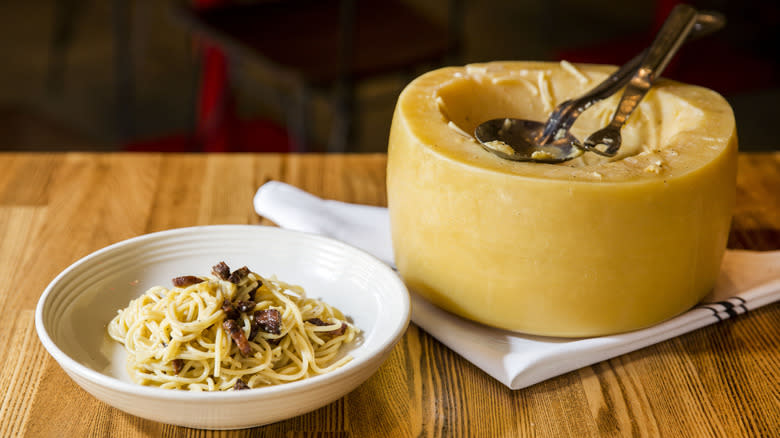What Is Cheese Wheel Pasta (And Is It Just A Gimmick)?

Many people are adamant that pasta sauce always tastes better at a restaurant, so we can only imagine how much more common that sentiment would become with widespread awareness of cheese wheel pasta. Yes, an entire cheese wheel, brought directly to your table. Some may think this is a gimmick, but cheese wheel pasta dates back at least a decade — if not centuries.
Before you get your hopes up about demolishing an entire wheel of Grana Padano, just know that the cheese wheel serves as more of a finishing touch to a dish. At best, it's a serving vessel rather than a part of the dish itself.
For this trick, restaurants generally carve a bowl-sized indentation into a cheese wheel, then pour in freshly cooked pasta per order. The heat from the pasta melts the adjacent cheese, allowing it to generously coat the noodles and any other toppings. Once the pasta has been tossed to a customer's preference, it's usually removed from the cheese wheel so the wheel can be shaved down and reused for another dish.
Read more: Waiters Reveal What Restaurants Get The Best Tips
A Brief History Of Cheese Wheel Pasta

Many popular dishes have a clear origin story, but not cheese wheel pasta. This particular method of preparing and serving pasta seems to have become mainstream only over the past decade, and any history before then is anyone's guess.
Restaurant consultant Marx Cyrus Cruz theorized in an Instagram post that the concept could be centuries old. He suggested that shepherds would carry cheese wheels with them, using the wheels as bowls, though corroborating this particular theory is difficult. However, historians can say with certainty that, as early as the Middle Ages, the Alps hosted a steady trade of cheese wheels, as wheels were easier to travel with than, say, a large brick of cheese.
Naturally, cheese wheels were soon present all across Europe, though their popularity likely had more to do with the shelf life and structure of a cheese wheel than anything else. As such, we completely understand why some Reddit users have offered up the idea that the whole "cheese wheel pasta" trend was simply created to drive tourism.
Common Variations Of Cheese Wheel Pasta

While each restaurant that serves cheese wheel pasta will have its own unique spin on the dish, most restaurants stick to the same general idea. One common cheese wheel pasta, for instance, is cacio e pepe, which is essentially the Italian version of mac and cheese. Restaurants commonly bring cacio e pepe to the table with a large wheel of parmesan or parmigiano reggiano, performing the pasta-tossing ritual inside the hollowed-out cheese.
Forma, a restaurant in Santa Monica that arguably increased cheese wheel pasta's popularity, offers cacio e pepe, fettuccine bolognese, risotto, and tortellini as its cheese wheel pasta options. In addition to parmigiano reggiano, Forma also offers pecorino romano, Grana Padana, and Bella Lodi cheeses. Meanwhile, Staten Island's Bocelli Ristorante serves a spaghettini with vodka flambé from a wheel of 30-month-old Grana Padana. Wherever you go for restaurant-grade cheese wheel pasta, your chefs and servers will make it an experience.
Enjoying (And Storing) The Cheese Wheel Pasta Phenomenon At Home

Unfortunately, restaurants offering cheese wheel pasta aren't accessible to everyone, whether because of location or cost. If you've got a family of five going out for cheese wheel pasta, which is about $30 per plate on average, you're already footing a minimum bill of $150.
As such, if you really love cheese and still want the cheese wheel pasta experience, you might consider investing in a wheel of your own. Sam's Club, for instance, sells a 15-pound parmesan cheese wheel for about $150, but you can also find smaller cheese wheels around 5 pounds for less than $60 online.
Of course, if you decide to invest in a wheel of cheese, you'll likely need to know how to properly store it. As is the case for storing any kind of cheese, your best option is to keep a cheese wheel in the fridge, especially once you've cut into it. After all, you don't want your cheese to grow an unfavorable kind of mold.
Read the original article on Mashed.

